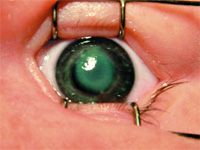Article
Improved vision is possible for children with mild form of Peters' anomaly
Author(s):
A better visual outcome can be achieved after corneal transplantation surgery in pediatric patients with Peters' anomaly type 1 if the surgery is performed when the patients are aged approximately 10 to 15 weeks and if the glaucoma and astigmatism are well controlled.

Key Points

"In this study, we wanted to determine what clinical characteristics might lead to the development of better vision after successful corneal transplant surgery in infants with Peters' anomaly type 1, which is the most common cause of congenital corneal opacities," said Dr. Zaidman, professor of ophthalmology, New York Medical College, Valhalla, NY. "Peters' anomaly involves a dense central corneal opacity with iris synechiae. The lens is not involved in this, the milder form of Peters' anomaly."
Dr. Zaidman and colleagues conducted a retrospective study that included all infants with Peters' anomaly type 1 (Figure 1) who underwent corneal transplant surgery at their institution. All patients in the study were aged at least 3 years and had clear grafts. The patients were divided into two groups based on whether best-corrected vision was better or worse than 20/100. Seven outcome measures were studied, including patient age at the time of surgery, the presence of glaucoma, the incidence of episodes of graft rejection, the amount of postoperative astigmatism, a history of cataract surgery or corneal infections, and compliance with the treatment regimen, Dr. Zaidman said.

Complications
The most commonly occurring surgical complications included glaucoma and high amounts of astigmatism (>2 D). Glaucoma developed in about 60% of children, and astigmatism exceeding 2 D was present in about 45% of children. Approximately 30% of the patients had episodes of graft rejection. Most of these episodes cleared, however, Dr. Zaidman said, and the grafts were not affected. Cataracts developed in about 25% of children and required surgery. Corneal ulcers developed in only a few children. Most of the patients adhered to the treatment regimens.
"When the complications were stratified by group, the children with better visual acuity had fewer of all complications," Dr. Zaidman said. "Many more children in the group with the poorer visual acuity developed glaucoma or high astigmatism and required cataract surgery. The graft rejections were evenly divided between the two groups."
Specifically, of the patients in whom glaucoma developed, seven were in the group with better visual acuity; none of these children required surgery, and medical management successfully controlled the glaucoma. In the group with poorer visual acuity, glaucoma developed in eight children, and 25% of these children underwent glaucoma filtering surgery or valve surgery.
Patient age at the time of surgery also was found to be a relevant factor in the treatment success of these patients' responses to treatment. Patients with better vision had surgery at a slightly younger age (4.3 months) compared with patients with poorer vision (6 months).
Newsletter
Don’t miss out—get Ophthalmology Times updates on the latest clinical advancements and expert interviews, straight to your inbox.




